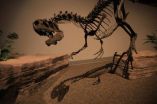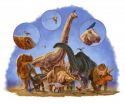(Press-News.org) While research has made great strides in recent decades to improve and significantly extend the lives of patients with early breast cancer, the needs of patients with advanced or metastatic disease have largely been ignored. Moreover, despite the fact that the overall breast cancer death rate has dropped steadily over the last decade and significant improvements in survival have been made, metastatic breast cancer represents the leading cause of death among patients with the disease.
In this context the Breast International Group (BIG) recently launched AURORA, which will use molecular screening to improve our understanding of metastatic breast cancer and its response or lack of response to available drug therapies. In total 1300 women and men from about 60 hospitals in 15 European countries are expected to take part in the programme. Over time, BIG hopes to expand the programme well beyond Europe to involve several 1000 more patients.
Dr Martine Piccart-Gebhart, Chair of BIG and Director of the Medicine Department of the Institut Jules Bordet, strongly believes in this research programme and says: "It is almost unethical that we continue to treat women with metastatic breast cancer when we have so little knowledge of their disease. We now have powerful technologies for investigating the molecular landscape of tumours, and we have an obligation to women to establish AURORA as a large translational research effort that can hopefully lead to more effective treatments in the future".
Within AURORA, metastatic and primary breast cancer tissue specimens will be collected and screened with a panel of more than 400 cancer-related genes for the first time on a large scale. Plasma and blood samples will also be collected, and any samples not analysed immediately will be stored in an independent bio-repository to enable future research. An innovative bioinformatics platform has been developed to support the collection of AURORA data. These data are being collected in a way that will allow sharing and collaborating in the context of other initiatives started by researchers in North America.
AURORA will enable scientists to understand both why breast cancer metastasises and why some patients respond poorly to standard treatment, while others respond very well. Whenever possible, patients participating in AURORA will be offered to participate in a clinical trial testing new and promising drugs that target the specific genetic characteristics of their tumours. The ultimate hope is that AURORA will benefit patients by leading us to both better treatments and to finding cures for the women and men affected by this disease.
INFORMATION:
AURORA is made possible in part by generous grants from the Breast Cancer Research Foundation (BCRF), the Fondation Cancer (Luxembourg), the National Lottery (Belgium), NIF Trust, and individual donors.
-- About Breast International Group (BIG) --
The Breast International Group (BIG) is a non-profit organisation for academic breast cancer research groups from around the world, with its headquarters in Brussels, Belgium. Founded by leading European opinion leaders in 1999, BIG now constitutes a network of 49 collaborative groups based in Europe, Canada, Latin America, Asia and Australasia. These entities are tied to several thousand specialised hospitals and research centres worldwide. About 30 clinical trials are run or are under development under the BIG umbrella at any one time. BIG also works closely with the US National Cancer Institute (NCI) and the North American Breast Cancer Group (NABCG), so that together they act as a strong integrating force in the breast cancer research arena.
BIG facilitates and accelerates international breast cancer research by stimulating cooperation between its members and other academic networks, and collaborating with, but working independently from, the pharmaceutical industry. Large-scale cooperation is crucial to make significant advances in breast cancer research, reduce unnecessary duplication of effort, and optimally serve those affected by the disease.
http://www.BIGagainstbreastcancer.org
-- About Martine Piccart-Gebhart --
Martine Piccart-Gebhart, MD, PhD is Professor of Oncology at the Université Libre de Bruxelles (ULB) and Director of the Medicine Department at the Institut Jules Bordet, Belgium. She is also co-founder and chair of the Breast International Group.
Dr Piccart-Gebhart is a member of numerous professional organisations, currently serving as President of the European CanCer Organisation (ECCO). She is immediate Past-President of the European Society for Medical Oncology (ESMO). From 2006 to 2009 she served as President of the European Organisation for Research and Treatment of Cancer (EORTC) and member of the American Society of Clinical Oncology (ASCO) board.
She has served as first author or co-author of about 400 scientific publications in peer-reviewed journals. She has received numerous awards in recognition of her achievements in the clinical research field, including the Jill Rose Award (New York), the William L. McGuire Award (San Antonio), the Umberto Veronesi Award for the Future Fight against Cancer (Cancun) and, recently, ASCO's David A. Karnofsky Memorial Award (Chicago).
-- About IMPAKT Breast Cancer Conference --
Jointly organised by BIG and the European Society for Medical Oncology (ESMO), the sixth edition of the IMPAKT Breast Cancer Conference will figure out how to best develop and better individualise new strategies to fight against breast cancer, putting current and future issues into perspective. In recent years, translational research in breast cancer has evolved at such a fast pace that it has made all believe that our dream of truly personalised medicine in breast cancer might soon become a reality. However, despite some advances, there are still many research goals to be achieved.
Having laboratory discoveries translated into clinical practice is what patients need, but it is equally important that data collected in the clinic get back to researchers to allow them to dig more deeply into the biological behaviour of the disease. Around 450 attendees are expected from throughout Europe and the rest of the world.
http://www.impakt.org
-- IMPAKT Media registration --
BIG and ESMO welcome media interested in obtaining information and reporting on cancer issues. Registration is free to bona fide journalists on presentation of a letter of assignment and a valid press card. To register for the event, please complete Media Registration Form at http://www.impakt.org (Press & Media section).
-- Media contacts --
For questions about AURORA and BIG
Cecilia Waldvogel
Communications Manager, Breast International Group (BIG)
Email: cecilia.waldvogel@BIGagainstbc.org
Mobile phone: +41 79 478 02 38
For questions about IMPAKT and ESMO
Vanessa Pavinato
Press Officer, European Society for Medical Oncology (ESMO)
Email: media@esmo.org
Mobile phone: +41 79 935 60 73
International molecular screening program for metastatic breast cancer AURORA at IMPAKT
AURORA, the first international molecular screening programme for metastatic breast cancer, presented at IMPAKT Breast Cancer Conference
2014-05-07
ELSE PRESS RELEASES FROM THIS DATE:
Nearest bright 'hypervelocity star' found
2014-05-07
SALT LAKE CITY, May 7, 2014 – A University of Utah-led team discovered a "hypervelocity star" that is the closest, second-brightest and among the largest of 20 found so far. Speeding at more than 1 million mph, the star may provide clues about the supermassive black hole at the center of our Milky Way and the halo of mysterious "dark matter" surrounding the galaxy, astronomers say.
"The hypervelocity star tells us a lot about our galaxy – especially its center and the dark matter halo," says Zheng Zheng, an assistant professor of physics and astronomy and lead author ...
All teeth and claws? New study sheds light on dinosaur claw function
2014-05-07
Theropod dinosaurs, a group which includes such famous species as Tyrannosaurus rex and Velociraptor, are often regarded as carnivorous and predatory animals, using their sharp teeth and claws to capture and dispatch prey. However, a detailed look at the claws on their forelimbs revealed that the form and shape of theropod claws are highly variable and might also have been used for other tasks.
Inspired by this broad spectrum of claw morphologies, Dr Stephan Lautenschlager from Bristol's School of Earth Sciences studied the differences in claw shape and how these are ...
Revealing the healing of Dino-sores
2014-05-07
Scientists have used state-of-the-art imaging techniques to examine the cracks, fractures and breaks in the bones of a 150 million-year-old predatory dinosaur.
The University of Manchester researchers say their groundbreaking work – using synchrotron-imaging techniques – sheds new light, literally, on the healing process that took place when these magnificent animals were still alive.
The research, published in the Royal Society journal Interface, took advantage of the fact that dinosaur bones occasionally preserve evidence of trauma, sickness and the subsequent signs ...
Study finds pregnant women show increased activity in right side of brain
2014-05-07
Pregnant women show increased activity in the area of the brain related to emotional skills as they prepare to bond with their babies, according to a new study by scientists at Royal Holloway, University of London.
The research, which will be presented at the British Psychological Society's annual conference on Wednesday 7 May, found that pregnant women use the right side of their brain more than new mothers do when they look at faces with emotive expressions.
"Our findings give us a significant insight into the 'baby brain' phenomenon that makes a woman more sensitive ...
Mass vaccination campaigns reduce the substantial burden of yellow fever in Africa
2014-05-07
Yellow fever, an acute viral disease, is estimated to have been responsible for 78,000 deaths in Africa in 2013 according to new research published in PLOS Medicine this week. The research by Neil Ferguson from Imperial College London, UK and colleagues from Imperial College, WHO and other institutions also estimates that recent mass vaccination campaigns against yellow fever have led to a 27% decrease in the burden of yellow fever across Africa in 2013.
Yellow fever is a serious viral disease that affects people living in and visiting tropical regions of Africa and ...
Water from improved sources is not consistently safe
2014-05-07
Although water from improved sources (such as piped water and bore holes) is less likely to contain fecal contamination than water from unimproved sources, improved sources in low- and middle-income countries are not consistently safe, according to a study by US and UK researchers, published in this week's PLOS Medicine.
These findings are important as WHO and UNICEF track progress towards the Millennium Development Goals water target using the indicator "use of an improved source": this study shows that assuming that "improved" water sources are safe greatly overestimates ...
Dinosaurs and birds kept evolving by shrinking
2014-05-07
Although most dinosaurs went extinct 65 million years ago, one dinosaur lineage survived and lives on today as a major evolutionary success story – the birds. But to what does this lineage owe its success? A study that has 'weighed' hundreds of dinosaurs now suggests that shrinking their bodies may have helped this group to continue exploiting new ecological niches throughout their evolution, and to become such a diverse and widespread group of animals today.
An international team, led by scientists from Oxford University and the Royal Ontario Museum, estimated the body ...
Shrinking helped dinosaurs and birds to keep evolving
2014-05-07
A study that has 'weighed' hundreds of dinosaurs suggests that shrinking their bodies may have helped the group that became birds to continue exploiting new ecological niches throughout their evolution, and become hugely successful today.
An international team, led by scientists at Oxford University and the Royal Ontario Museum, estimated the body mass of 426 dinosaur species based on the thickness of their leg bones. The team found that dinosaurs showed rapid rates of body size evolution shortly after their origins, around 220 million years ago. However, these soon slowed: ...
Patients with AMD may not need monthly injections
2014-05-07
Orlando, Fla. — Researchers have found that, contrary to prvious clinical trial findings, monthly injections to counteract age-related macular degeneration (AMD) may not be necessary. The research is being presented at the 2014 Annual Meeting of the Association for Research in Vision and Ophthalmology (ARVO) this week in Orlando, Fla.
The investigators used a strategy called "treat and extend" to conduct the study, in which the frequency of office visits and injections were tailored to each patient's individual response to therapy. Following 185 patients over a three-and-a-half-year ...
AGU journal highlights -- May 6, 2014
2014-05-06
The following highlights summarize research papers that have been recently published in Geophysical Research Letters (GRL), Journal of Geophysical Research: Earth Surface (JGR-F), Journal of Geophysical Research: Oceans (JGR-C), and Water Resources Research (WRR).
In this release:
1. Polar hexagon-shaped jet stream could reveal Saturn's rotational period
2. Antarctica's Whillans Ice Plain ice flows are highly variable
3. Climate change, water rights, and agriculture: A case study in Idaho
4. Low impact development boosts groundwater recharge
5. Beaufort Gyre sea ...
LAST 30 PRESS RELEASES:
Numbers in our sights affect how we perceive space
SIMJ announces global collaborative book project in commemoration of its 75th anniversary
Air pollution exposure and birth weight
Obstructive sleep apnea risk and mental health conditions among older adults
How talking slows eye movements behind the wheel
The Ceramic Society of Japan’s Oxoate Ceramics Research Association launches new international book project
Heart-brain connection: international study reveals the role of the vagus nerve in keeping the heart young
Researchers identify Rb1 as a predictive biomarker for a new therapeutic strategy in some breast cancers
Survey reveals ethical gaps slowing AI adoption in pediatric surgery
Stimulant ADHD medications work differently than thought
AI overestimates how smart people are, according to HSE economists
HSE researchers create genome-wide map of quadruplexes
Scientists boost cell "powerhouses" to burn more calories
Automatic label checking: The missing step in making reliable medical AI
Low daily alcohol intake linked to 50% heightened mouth cancer risk in India
American Meteorological Society announces Rick Spinrad as 2026 President-Elect
Biomass-based carbon capture spotlighted in newly released global climate webinar recording
Illuminating invisible nano pollutants: advanced bioimaging tracks the full journey of emerging nanoscale contaminants in living systems
How does age affect recovery from spinal cord injury?
Novel AI tool offers prognosis for patients with head and neck cancer
Fathers’ microplastic exposure tied to their children’s metabolic problems
Research validates laboratory model for studying high-grade serous ovarian cancer
SIR 2026 delivers transformative breakthroughs in minimally invasive medicine to improve patient care
Stem Cell Reports most downloaded papers of 2025 highlight the breadth and impact of stem cell research
Oxford-led study estimates NHS spends around 3% of its primary and secondary care budget on the health impacts of heat and cold in England
A researcher’s long quest leads to a smart composite breakthrough
Urban wild bees act as “microbial sensors” of city health.
New study finds where you live affects recovery after a hip fracture
Forecasting the impact of fully automated vehicle adoption on US road traffic injuries
Alcohol-related hospitalizations from 2016 to 2022
[Press-News.org] International molecular screening program for metastatic breast cancer AURORA at IMPAKTAURORA, the first international molecular screening programme for metastatic breast cancer, presented at IMPAKT Breast Cancer Conference



